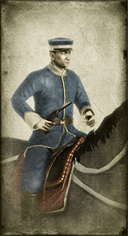
Basic Unit Statistics (can be modified by difficulty level, arts, skills, traits and retainers)
| Recruitment Cost | 270 | |
| Upkeep Cost | 90 | |
| Melee Attack | 18 | 51% |
| Charge Bonus | 15 | 30% |
| Bonus vs Cavalry | 0 | 0% |
| Range | 70 | 10% |
| Accuracy | 40 | 40% |
| Reloading Skill | 45 | 45% |
| Ammunition | 12 | 15% |
| Melee Defence | 10 | 28% |
| Armour | 2 | 13% |
| Morale | 12 | 24% |
Strengths & Weaknesses
- General provides morale bonus to nearby units.
- Lots of powerful special abilities.
- Short range.
- Weak in melee.
- Weak against missile attacks and spear units.
- Very good morale.
Abilities
- Ganbatte - This ability allows the general to encourage a single unit for a short period of time, further boosting their morale and greatly improving their accuracy and melee skills.
- Inspire Unit - This unit can choose to inspire a single unit for a short period of time, boosting their morale and greatly improving their marksmanship and melee skills.
- Rally - This unit can rally troops within his area of influence.
- Regroup Position - This general can declare a rally position for withdrawing and routing units to pull back to, and reinforcing units to move towards.
Description
It is not a general's place to fight. He has a battle to organise.
Armed and equipped in European style, this general's bodyguard unit are there to keep their commander from being personally bothered by enemies. His job is to move along the line of battle, issuing orders and offering morale support to his troops. His special abilities more than make up for the unit's lack of direct, concrete fighting strength. It is most definitely not his task to get involved in fighting the enemy. The small numerical size of the bodyguard means that the general will not survive for long in close combat, even though his men carry sabres. It is also a good idea to keep the general out of range of enemy sharpshooters and artillery: death does not respect the gold braid on a general's epaulettes. While 19th Century generals were killed in action, the size, scope and range of activities carried out by a modern army of the period meant that being in the thick of things was the one place it made little or no sense to be. A general needed to be mobile, and to keep his wits (and possibly a good telescope) about him if he was to have any chance of controlling a battle. While divisional commanders might lead a charge, it was now the army commander's job to supervise and co-ordinate. This was a pattern of command that Napoleon had understood perfectly years earlier, but it applied more than ever.